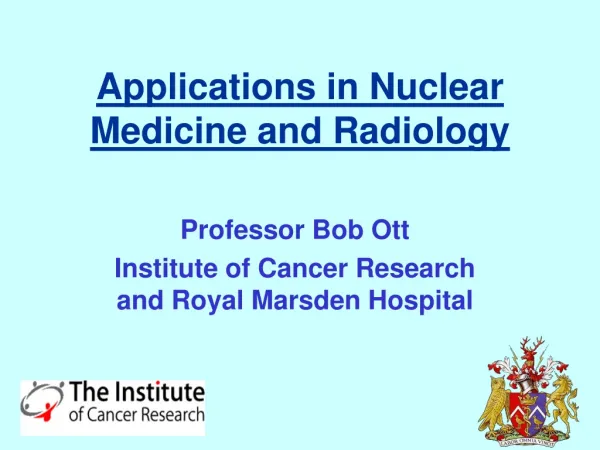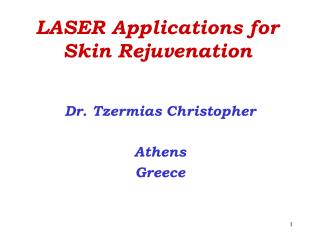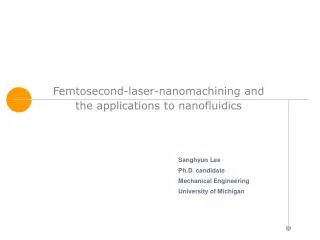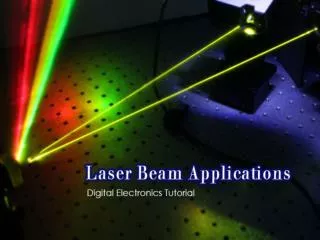LASER APPLICATIONS TO MEDICINE AND
LASER APPLICATIONS TO MEDICINE AND. Prof. Dr. Moustafa . M. Mohamed Vice Dean Faculty of Allied Medical Science Pharos University Alexandria Dr. Yasser khedr Department of Medical Biophysics Pharos University. Types of lasers. According to the active material:
Share Presentation
Embed Code
Link
Download Presentation
- quartz flash
- stimulates
- solid matrix
- healthy cells
- reactive gases
- higher energy levels

katina + Follow
Download Presentation
LASER APPLICATIONS TO MEDICINE AND
An Image/Link below is provided (as is) to download presentation Download Policy: Content on the Website is provided to you AS IS for your information and personal use and may not be sold / licensed / shared on other websites without getting consent from its author. Content is provided to you AS IS for your information and personal use only. Download presentation by click this link. While downloading, if for some reason you are not able to download a presentation, the publisher may have deleted the file from their server. During download, if you can't get a presentation, the file might be deleted by the publisher.
Presentation Transcript
- LASER APPLICATIONS TO MEDICINE AND Prof. Dr. Moustafa. M. Mohamed Vice Dean Faculty of Allied Medical Science Pharos University Alexandria Dr. Yasser khedr Department of Medical Biophysics Pharos University
- Types of lasers • According to the active material: solid-state, liquid, gas, excimer and semiconductor lasers. • According to the wavelength: Infra-red (IR), Visible, Ultra-violet (UV) or X-ray Lasers.
- Types of lasers • Solid-state lasers have lasing material distributed in a solid matrix (such as ruby or Nd-YAG). Flash lamps are the most common power source. The Nd-YAG laser emits infrared light at 1.064 nm. • Semiconductor lasers, sometimes called diode lasers, are p-n junctions. Current is the pump source. Applications: laser printers or CD players.
- Types of lasers • Dye lasers use complex organic dyes. • • Gas lasers are pumped by current. Helium-Neon (He-Ne) lasers in the visible and IR. Argon lasers in the visible and UV. CO2 lasers emit light in the far-infrared (10.6 mm), and are used for cutting hard materials.
- Excimer lasers: (from the terms excited and dimers) use reactive gases, such as chlorine and fluorine, mixed with inert gases such as argon, krypton, or xenon. When electrically stimulated, a pseudo molecule (dimer) is produced. Excimers laser in the UV.
- Solid-state Laser • Example: Ruby Laser • Operation wavelength: 694.3 nm (IR) • 3 level system: absorbs green/blue • Gain Medium: crystal of aluminum oxide (Al2O3) with small part of atoms of aluminum is replaced with Cr3+ ions. • Pump source: flash lamp • The ends of ruby rod serve as laser mirrors.
- Ruby Laser
- How Ruby laser works? • 1. High-voltage electricity causes the quartz flash tube to emit an intense burst of light, exciting some of Cr3+ in the ruby crystal to higher energy levels.
- How Ruby laser works? • 2. At a specific energy level, some Cr3+ emit photons. At first the photons are emitted in all directions. Photons from one Cr3+ stimulate emission of photons from other Cr3+ and the light intensity is rapidly amplified.
- How Ruby laser works? • 3. Mirrors at each end reflect the photons back and forth, continuing this process of stimulated emission and amplification
- How Ruby laser works? • 4. The photons leave through the partially silvered mirror at one end. This is laser light.
- High and Low Level Lasers • High Level Lasers –Surgical Lasers –Hard Lasers –Thermal –Energy (3000-10000) mW
- Low Level Lasers –Medical Lasers –Soft Lasers –Subthermal –Energy (1-500) mW –Therapeutic (Cold) lasers produce maximum output of 90 mW or less (600-1000) nm light
- Parameters • Laser –Wavelength –Output power – Average power – Intensity –Dosage
- Wavelength • Nanometers (nm) • Longer wavelength (lower frequency) = greater penetration • Not fully determined • Wavelength is affected by power
- Power • Output Power –Watts or milliwatts (W or mW) –Important for laser safety • Intensity • Power Density (intensity) • –W or mW/ cm2 • – Takes into consideration – actual beam diameter • – Beam diameter determines power density
- Average Power • Knowing average power is important in determining dosage with pulsed laser • If laser is continuous – average power = peak output power • If laser is pulsed, then average power is equal to peak output power X duty cycle.
- Energy Density • Dosage (D): Amount of energy applied per unit area • Measured in Joules/square cm (J/cm2) – Joule – unit of energy – 1 Joule = 1 W/sec • Dosage is dependent on: –Output of laser in mW. – Time of exposure in seconds. – Beam surface area of laser in cm2
- Laser Treatment & Diagnostics • Treatment cover everything from the ablation of tissue using high power lasers to photochemical reaction obtained with a weak laser. • Diagnostics cover the recording of fluorescence after excitation at a suitable wavelength and measuring optical parameters.
- Laser Tissue Interaction:
- What Does Laser Do? • Laser light waves penetrate the skin with no heating effect, no damage to skin & no sideeffects. • Laser light directs biostimulative light energy to the body’s cells which convert into chemical energy to promote natural healing & pain relief. • Stimulation of wound healing – Promotes faster wound healing/clotformation –Helps generate new & healthy cells & tissue
- What Does Laser Do? • Increase collagen production –Develops collagen & muscle tissue • Increase macrophage activity – Stimulates immune system • Alter nerve conduction velocity – Stimulates nerve function
- What Does Laser Do? • Improved blood circulation & vasodilation – Increases blood supply • Increases ATP production • Analgesic effect – Relieves acute/chronic pain • Anti-inflammatory & anti-edematous effects – Reduces inflammation
- Tissue & Cellular Response • Magnitude of tissue’s reaction are based on physical characteristics of: –Output wavelength/frequency –Density of power –Duration of treatment – Vascularity of target tissues
- Direct and indirect laser effects • Direct effect – occurs from absorption of photons • Indirect effect – produced by chemical events caused by interaction of photons emitted from laser and the tissues
- LASER Regulation • Lasers are classified according to the hazard; * Class 1 and 1M (magnifier) lasers are considered safe * Class 2 and 2M (magnifier) - emit visible light at higher levels than Class 1, - eye protection is provided - can be hazardous if the beam is viewed directly with optical instruments;
- * Class 3R (Restricted) Laser - produce visible and invisible light that are hazardous under direct viewing conditions; * Class 3B lasers - produce visible or invisible light that is hazardous under direct viewing conditions - they are powerful enough to cause eye damage in a time shorter - Laser products with power output near the upper range of Class 3B may also cause skin burns;
- * Class 4 lasers - high power devices capable of causing both eye and skin burns, - heir diffuse reflections may also be hazardous - the beam may constitute a fire hazard;

Applications in Nuclear Medicine and Radiology
Applications in Nuclear Medicine and Radiology. Professor Bob Ott Institute of Cancer Research and Royal Marsden Hospital. Topics. Digital x-ray imaging Fast CT scanning SPECT scanners for small animals SPECT/CT scanning PET scanners for small animals New crystals for PET and SPECT
632 views • 34 slides

Laser Applications
Laser Applications. Page 149. Ophthalmic lasers provide good examples of three fundamental laser applications, based on: total output energy (thermal effects, photocoagulation ) output power (tissue ionization, photodisruption ) photon energy (breaking molecular bonds, photoablation ).
3.68k views • 38 slides

cDNA Microarrays and some of their applications to Clinical Medicine
cDNA Microarrays and some of their applications to Clinical Medicine. Pascale F. Macgregor, Ph. D. LMP 1019S April 12, 2002. Outline of the lecture. What are microarrays? **Manufacturing **Different types of microarrays **Possible applications **Data analysis
858 views • 57 slides

Topic : Laser And it’s Applications
Topic : Laser And it’s Applications. Created by :- Het Mehta (34) Ankit Patel (42) Amit Tiwary (03) Nirav Patel (45) Bhavesh Nakum (38) . Definition Of LASER
578 views • 13 slides

Laser Impressions, Inc. Applications of laser engraving
Laser Impressions, Inc. Applications of laser engraving. Company Profile Laser Impressions, Inc. LINK: www.laserimp.com 1203 Alderwood Ave. Sunnyvale, CA 94089-2202 USA Phone: (408) 734-2012 (800) 344-LASER. Wafer engraving.
279 views • 7 slides
 Laser Theory and Applications to Lasers in Medicine" width="320px" />
Laser Theory and Applications to Lasers in Medicine" width="320px" />
Laser Theory and Applications to Lasers in Medicine
Laser Theory and Applications to Lasers in Medicine. http://upload.wikimedia.org/wikipedia/commons/a/a0/Military_laser_experiment.jpg. http://www.life123.com/bm.pix/bigstockphoto_close_up_of_eye_surgery_catar_2264267.s600x600.jpg. Background Image: http://www.nano.org.uk/news/july2008/1483.jpg.
519 views • 18 slides

MicroRNA’s applications in medicine
MicroRNA’s applications in medicine . microRNA Related Publications. Source: PubMed. lin-14; lin-4 relationship. 1. lin-4 encodes small RNAs with antisense complementarity to lin-14 3’ UTR .[Cell, 75, 843 (1993)]
1.12k views • 87 slides

Arbitrary nonparaxial accelerating beams and applications to femtosecond laser micromachining
Arbitrary nonparaxial accelerating beams and applications to femtosecond laser micromachining. F. Courvoisier , A . Mathis, L . Froehly, M. Jacquot, R. Giust, L . Furfaro, J . M. Dudley. FEMTO-ST Institute University of Franche-Comté Besançon, France. Accelerating beams.
564 views • 35 slides

Evidence-Based Ethics: Introduction and Applications to Medicine and Public Health
John E. Snyder. Evidence-Based Ethics: Introduction and Applications to Medicine and Public Health . Outline. Introduction History of medical ethics Key ethical principles Advance Directives Cases Applications to public health. Introduction. A need for practical medical ethics education
781 views • 47 slides

APPLICATIONS OF TERRESTRIAL LASER SCANNING
Proceedings of Challenges in the European Area: Young Scientist’s 1st International Baku Forum, 20-25 May 2013 Baku AZERB AI JAN. APPLICATIONS OF TERRESTRIAL LASER SCANNING . Karolina Hejbudzka , PhD student Andrzej Dumalski , PhD
1.51k views • 11 slides

New high-power ultrafast laser and potential applications in biology and medicine
New high-power ultrafast laser and potential applications in biology and medicine. University of Surrey School of Physics and Chemistry Guildford, Surrey GU2 7XH, UK. Jeremy Allam Optoelectronic Devices and Materials Research Group Tel +44 (0)1483 876799 Fax +44 (0)1483 876781.
440 views • 12 slides

Applications of the CXS to Cancer Medicine
U T is the total unsharpness F is the intrinsic receptor unsharpness m is the magnification a is the source size. 1. Contrast relative to normal breast tissue. 0.1 mm calcification. .1. T. m 1. x. m 2. .01. 1 mm glandular tissue. .001. 10. 20. 30. 40. 50. Energy (keV).
123 views • 2 slides

LASER Applications for Skin Rejuvenation
LASER Applications for Skin Rejuvenation. Dr. Tzermias Christopher Athens Greece. LASER Applications for Skin Rejuvenation. Traditional rejuvenation techniques (CO 2 , Er:YAG) characterized by top–to–bottom injuries, sacrifice epidermis to achieve subsequent dermal remodeling.
747 views • 18 slides

Femtosecond-laser-nanomachining and the applications to nanofluidics
Femtosecond-laser-nanomachining and the applications to nanofluidics. Sanghyun Lee Ph.D. candidate Mechanical Engineering University of Michigan. BACK GROUND. Fast growing microfluidics markets “Microfluidics Technology”, BCC Research, 2006
624 views • 34 slides

Laser Beam Applications | Electrodiction
This ppt educates about various aspects of Laser Beam-- Lase diode that produces it, its characteristics and applications in medical, military and social sphere and its basic differences with normal light and also LED. for engaging electronics tutorial on Digital science, check http://www.electrodiction.com/digital-electronics
599 views • 9 slides

Applications of Nanotechnology to Medicine
Applications of Nanotechnology to Medicine. December 2014. Areas of impact. Drug delivery and new therapies Diagnostic analyses Biological research. Drug Delivery. Nanoscience, translation, clinic. http://lapotko.rice.edu. Commercial Nanotherapeutics.
523 views • 28 slides

The Laser Laboratory for Acceleration and Applications
The Laser Laboratory for Acceleration and Applications. International Conference on Accelerator Optimization Sevilla, 7-9 Octubre 2015. José Benlliure. Universidad of Santiago de Compostela. Laser-plasma acceleration. José Benlliure.
372 views • 36 slides

LASER APPLICATIONS IN ELECTRONICS AND COMMUNICATIONS ENGINEERING
LASER APPLICATIONS IN ELECTRONICS AND COMMUNICATIONS ENGINEERING. By Asst. Prof. Dr. Nahlah Qader Mohammed Physics Department- College of Education Salahaddin University 27 th January 2019. LASER IN OPTOELECTRONICS. OPTICAL FIBER COMMUNICATIONS. OPTICAL FIBER SENSORS.
621 views • 34 slides

9 Applications of Laser Machines
This article gives insights about the ways laser cutting machines are useful to manufacturers in different industries and the benefits it brings along. Read more.

Applications Of Laser Cutting
Do you know the application of laser cutting, how laser cutting beneficial? Then read this infographic to know the application of laser cutting.








 Laser Theory and Applications to Lasers in Medicine" width="320px" />
Laser Theory and Applications to Lasers in Medicine" width="320px" />












